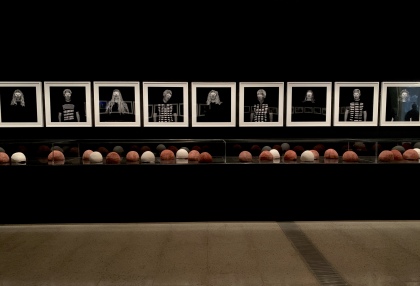Submitted Review
NGV Triennial: Angela Tiatia's Narcissus
‘The son of a god has become God; the 21st Century belongs to Narcissus.’
Gestating over the past century, corresponding with the rise of industry, technology and Capitalism, the son of a god has become God; the 21st Century belongs to Narcissus.
Returning to the NGV Triennial on repeat visits, as one ought, draws me back into the British and European Collection 17th – 18th Centuries room thick with darkness, pierced with focused illuminations onto four glorious 17th century paintings, and on one massive wall a magnificent large-scale projection of Angela Tiatia’s time-based work ‘Narcissus’ (2019).
A choreographed moving image in slow motion, a larger-than-life crowd pulsates with writhing, aggressive madness – all zealously clawing their way to the pool of self-obsession and annihilation. A modern male beauty evocative of Caravaggio’s circa 1597 depiction is our central protagonist. The palette and pose of this singular beauty are overt references to the work, becoming a glorious homage as the scene slowly travels down the wall revealing for a moment the perfect frame – an infinite circular composition created through connection of body, arms, head, and their mirror image reflection in the water.
Tiatia understands the power of beauty, and conversely its burdens and weaknesses. She manipulates this power expertly throughout her practice, particularly within the medium of the moving image, returning here to a recurring theme – water.
Water is a recurring theme for Tiatia. Akin to previous works ‘Tuvalu’, ‘Lick’ and ‘Holding On’, ‘Narcissus’ is a performative, political, activist work telling the world climate change is here. Tiatia, a Samoan woman, bears witness.
She is not alone in this room, sharing it with Jusepe de Ribera (Martyrdom of Saint Lawrence 1620-24) and his apprentice Luca Giordano (Saint Sebastian being cured by Irene c.1653 and Allegory c.1675) and Orazio Gentileschi (The Mocking of Christ 1628-1635). Assumingly curated with purpose as they all directly or indirectly connect with Caravaggio and fascinatingly bring forth another beautiful reference in Tiatia’s work; who would have thought we would watch tensions between Mannerist and Baroque aesthetic sensibilities centuries later in a video installation in Melbourne? The chiaroscuro, drama and painterly beauty of each painting relates to the same aesthetic properties in new media. It is the cleverness invested in her work that sets her apart in this medium, she excels with it.
Narcissus has competitors. Everyone desires to be the god of the selfie religion.
One contender is so mad with fervour he dives right into water, others join him disappearing under the surface. A silver-haired woman drinks and submits, down she goes.
Then Narcissus himself falls! Only to be immediate replaced. The whole scene slowly sinks as one solitary illuminated arm is left raised before it too succumbs to the depths.
Your reflection is not going to save you.
The water is rising.
MS
Marielle Soni
Images: Stills from Angela Tiatia, Narcissus, 2019, single-channel 2k High Definition video, colour, sound, 13 min, 24 sec.
Installation images from NGVTriennial.









No Comments